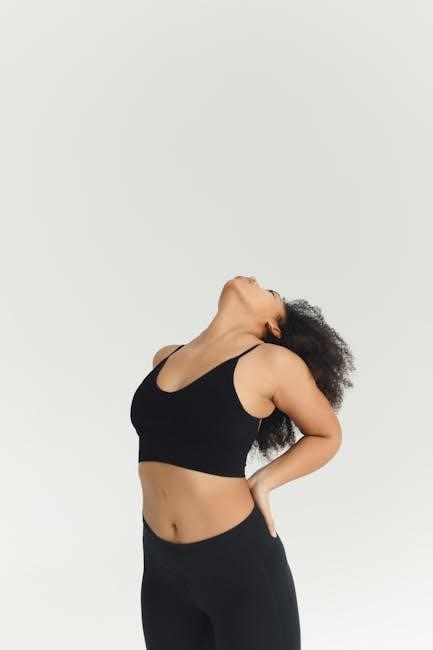Gluteus medius stretching is essential for improving hip stability, preventing injuries, and enhancing mobility. Regular stretching helps alleviate tightness, common in sedentary individuals and athletes, promoting overall lower body health.
What is the Gluteus Medius Muscle?
The gluteus medius is a key muscle located on the outer hip, playing a crucial role in hip abduction, stabilization, and pelvic alignment. It helps in movements like walking, running, and maintaining balance. Weakness or tightness in this muscle can lead to postural imbalances and hip-related pain. Strengthening and stretching the gluteus medius are essential for overall lower body functionality and injury prevention.
Why Stretching the Gluteus Medius is Important
Stretching the gluteus medius is vital for maintaining hip stability, improving mobility, and reducing the risk of injuries. Tightness in this muscle can lead to poor posture, lower back pain, and limited movement. Regular stretching helps to enhance flexibility, alleviate discomfort, and prevent conditions like hip impingement. It also supports athletes and individuals with active lifestyles by improving performance and reducing muscle strain. Incorporating gluteus medius stretches into your routine promotes overall hip health and proper pelvic alignment.
Common Causes of Gluteus Medius Tightness
Tightness in the gluteus medius often arises from prolonged sitting, sedentary lifestyles, or repetitive activities like running. Overuse in sports or exercises that strain the hip can also contribute. Poor posture, such as a lateral pelvic tilt, may cause uneven stress on the muscle. Additionally, muscle imbalances, where the gluteus medius becomes overactive to compensate for weaker surrounding muscles, can lead to tightness. Addressing these factors through targeted stretches and exercises is crucial for maintaining proper hip function and preventing discomfort.

Anatomy and Function of the Gluteus Medius
The gluteus medius, located on the outer hip, is a deep gluteal muscle essential for hip abduction, medial rotation, and pelvic stability during movement, ensuring proper gait and posture.
Location and Structure of the Gluteus Medius
The gluteus medius is located on the outer hip, beneath the gluteus maximus, originating from the ilium bone and inserting into the greater trochanter of the femur. This deep gluteal muscle is fan-shaped, with fibers radiating outward to provide stability and movement. Its structure allows it to play a crucial role in hip abduction, medial rotation, and pelvic alignment, making it essential for balanced gait and posture. Proper functioning of this muscle is vital for preventing hip and lower back issues.
Primary Functions of the Gluteus Medius
The gluteus medius primarily functions in hip abduction, medial rotation, and stabilization of the pelvis during gait. It ensures proper alignment and balance, preventing excessive pelvic tilt or hip collapse. This muscle is crucial for maintaining single-leg stance stability, reducing compensatory movements, and enabling smooth, efficient walking and running patterns. Its role in controlling hip and pelvic mechanics makes it essential for preventing injuries and supporting functional movements like climbing stairs or changing direction during sports.
How the Gluteus Medius Affects Hip and Pelvic Alignment
The gluteus medius plays a pivotal role in maintaining proper hip and pelvic alignment. When functioning optimally, it stabilizes the pelvis during movement, preventing excessive tilt or rotation. Weakness or tightness in the gluteus medius can lead to misalignment, such as a lateral pelvic tilt, where one hip sits higher than the other. This misalignment can strain surrounding muscles, leading to poor posture, lower back pain, and increased risk of injury during physical activities.

Benefits of Stretching the Gluteus Medius
- Improves hip flexibility and overall lower body mobility.
- Reduces the risk of hip-related injuries and strain.
- Enhances athletic performance and endurance during physical activities.
- Provides relief from lower back and pelvic pain.
Improved Hip Mobility and Flexibility
Stretching the gluteus medius enhances hip mobility by loosening tight muscles, allowing for a fuller range of motion. This flexibility reduces stiffness and strain during activities like walking or running. Regular stretching promotes better joint alignment, decreasing the risk of overuse injuries. Improved mobility also supports proper posture and balance, making daily movements more effortless and comfortable. Incorporating targeted stretches can significantly enhance overall hip function and lower body coordination, benefiting both sedentary individuals and active athletes alike.
Reduced Risk of Hip-Related Injuries
Stretching the gluteus medius reduces the risk of hip-related injuries by addressing muscle tightness and imbalances. Tightness in this muscle can lead to poor hip alignment, increasing the likelihood of conditions like IT band syndrome or hip impingement. Regular stretching improves joint stability, reducing strain on surrounding tissues. This can prevent overuse injuries common in runners and cyclists. By enhancing muscle flexibility and balance, gluteus medius stretching helps maintain proper hip mechanics, lowering the risk of chronic pain and injury during physical activity.
Enhanced Athletic Performance
Stretching the gluteus medius enhances athletic performance by improving muscle balance and hip stability. This allows for more efficient power transfer during movements like running, cycling, and jumping. Tight glutes can limit stride length and gait efficiency, while stretching promotes better range of motion and synchronization of muscle groups. This reduces injury risk and enhances endurance, enabling athletes to maintain peak performance during prolonged activities. Regular stretching also supports faster recovery and better execution of sport-specific skills, making it a key component of training regimens for optimal results.
Relief from Lower Back and Pelvic Pain
Stretching the gluteus medius can provide significant relief from lower back and pelvic pain. Tightness in this muscle often leads to pelvic misalignment, placing additional strain on the lower back. By releasing tension in the gluteus medius, individuals can restore proper pelvic alignment and reduce discomfort. Regular stretching helps alleviate muscle imbalances, improves joint mobility, and reduces the likelihood of chronic pain. This makes it an essential practice for those experiencing persistent lower back or pelvic discomfort, promoting long-term relief and improved overall spinal health.

Common Signs of a Tight Gluteus Medius
A tight gluteus medius often causes uneven hips, pain on the outer hip, difficulty maintaining proper posture, and limited range of motion during hip movements.
Uneven Hips or Pelvic Tilt
A tight gluteus medius often leads to uneven hips or a pelvic tilt, where one hip appears higher than the other. This misalignment can cause discomfort and affect posture. The gluteus medius plays a key role in stabilizing the pelvis during movements like walking or running. When tight, it can pull the pelvis down on one side, creating an uneven appearance. This imbalance may also contribute to limited range of motion and strain on the lower back. Addressing gluteus medius tightness can help restore proper pelvic alignment and reduce discomfort.
Pain or Discomfort on the Outer Hip
Pain or discomfort on the outer hip is a common symptom of a tight gluteus medius. This area, often referred to as the “hip abductor,” can become irritated due to overuse or prolonged sitting. A dull ache or sharp pain may develop, especially during activities like running, cycling, or twisting. This discomfort can mimic IT band syndrome but is specifically related to the gluteus medius muscle. Addressing this tightness through targeted stretching and strengthening exercises can help alleviate symptoms and improve overall hip function.
D difficulty Maintaining Proper Posture
D difficulty maintaining proper posture is often linked to tightness in the gluteus medius. This muscle plays a crucial role in stabilizing the hips and pelvis, and when it’s tight, it can pull the pelvis out of alignment, leading to uneven hips or a slouched posture. Over time, this can strain the lower back and make it challenging to stand or sit comfortably. Incorporating targeted stretches for the gluteus medius can help restore proper alignment and improve overall posture.
Limited Range of Motion During Hip Movements
Limited Range of Motion During Hip Movements
Limited range of motion during hip movements is a common sign of gluteus medius tightness. When this muscle is restricted, it can hinder proper hip abduction and external rotation, making activities like walking, running, or even sitting uncomfortable. Tightness reduces flexibility, causing the hips to feel stiff and less mobile. Incorporating targeted stretches, such as the seated figure four or side-lying stretches, can help improve hip mobility and restore a fuller range of motion, enhancing overall movement efficiency and comfort.

Effective Stretching Techniques for the Gluteus Medius
Seated figure four, side-lying, and prone stretches target the gluteus medius, improving flexibility and reducing muscle tension. Regular practice enhances hip mobility and overall lower body function.
Seated Figure Four Stretch
The Seated Figure Four Stretch is a highly effective technique for targeting the gluteus medius. Sit on a chair or the floor with a straight back and feet flat. Cross one ankle over the opposite knee, forming a “figure four” shape. Gently press down on the knee of the crossed leg to deepen the stretch. Hold for 20-30 seconds, focusing on the outer hip area. Maintain proper posture and avoid bouncing to ensure a safe, effective stretch. This stretch is particularly beneficial for those with tightness from sitting or overuse.
Side-Lying Gluteus Medius Stretch
Lie on your side with your legs slightly bent and feet touching. Slowly lift the top knee away from the bottom knee, keeping your feet together. Hold for 20-30 seconds, feeling the stretch in the outer hip. Ensure your pelvis remains neutral and avoid arching your back. This stretch is ideal for targeting the gluteus medius while maintaining a stable position. It’s particularly effective for improving hip flexibility and relieving tension caused by prolonged sitting or physical activity.
Standing Side Stretch
Stand with your feet hip-width apart, hands on your hips. Slowly lift your right knee outward, keeping your foot flexed, while maintaining pelvic alignment. Hold for 20-30 seconds, then switch sides. This stretch targets the gluteus medius, improving hip mobility and reducing muscle tension. Ensure smooth, controlled movements to maximize effectiveness and avoid discomfort. Regular practice can enhance flexibility and reduce the risk of hip-related injuries, making it ideal for both athletes and individuals with sedentary lifestyles.
Prone Gluteus Medius Stretch
Lie on your stomach with feet hip-width apart. Bend your right knee, bringing the foot toward your left shoulder. Lower your hips onto your heels, keeping your left leg straight. Hold for 20-30 seconds, focusing on the stretch in your outer hip. Switch sides and repeat. This stretch targets the gluteus medius, improving flexibility and reducing tightness. Perform 3-4 times weekly for consistent results and enhanced hip mobility.
Kneeling Hip Flexor Stretch
Kneel on one knee with the other foot flat in front. Shift your weight forward slightly, keeping your back straight. You should feel a gentle stretch in the front of your hip. Hold for 20-30 seconds and repeat on the other side. This stretch targets the hip flexors, which often tighten alongside the gluteus medius. Perform 3-4 times weekly to improve hip mobility and reduce tightness. Focus on maintaining proper form to maximize effectiveness and avoid discomfort.

Strengthening Exercises to Complement Stretching
Incorporate exercises like clamshell, side-lying leg lifts, and bird dog to strengthen the gluteus medius; These improve hip stability, enhance muscle balance, and prevent injury. Perform 3-4 times weekly for optimal results.
Gluteus Medius Strengthening with Resistance Bands is an effective way to target the muscle. Loop a resistance band around your legs just above the knees. Perform side-lying leg lifts or banded hip abductions, squeezing the glutes at the top of the movement. This exercise enhances strength, improves hip stability, and helps prevent imbalances. Use controlled movements and aim for 3 sets of 15-20 repetitions. Strengthening complements stretching by restoring muscle balance and function.
Side-Lying Leg Lifts
Side-lying leg lifts target the gluteus medius, enhancing hip stability and strength. Lie on your side with legs straight, lift the top leg slowly without bending the knee, then lower it. Use a resistance band for added challenge. Perform 3 sets of 15-20 repetitions on each side. This exercise improves hip abduction and pelvic alignment, reducing muscle tightness and promoting balanced lower body strength.
Bird Dog Exercise
Starting Position: Begin on your hands and knees, with your spine neutral. Action: Extend your right arm and left leg simultaneously, keeping them straight. Hold briefly, then return. Alternate sides. Benefits: Strengthens the gluteus medius, enhances core stability, and improves balance. Proper form ensures targeting the correct muscles without straining the lower back. Regular practice helps reduce pelvic misalignment and improves overall hip function.
Clamshell Exercise
Starting Position: Lie on your side with knees bent and feet touching. Action: Lift your top knee while keeping your feet together, squeezing your glutes. Hold briefly, then lower. Focus: Target the gluteus medius by ensuring movement comes from the hips, not the lower back. Benefits: Strengthens hip abductors, improves stability, and reduces pelvic tilt. Use a resistance band around the knees for added challenge. Proper form is key to avoid straining the lower back and maximize muscle engagement.
Single-Leg Balance Exercises
Stand on one leg, keeping the other foot lifted slightly off the ground. Engage your core and maintain a straight spine. Hold for 30-60 seconds, then switch legs. Progression: Close your eyes or stand on a soft cushion for added challenge. Benefits: Improves balance, hip stability, and gluteus medius strength. This exercise enhances posture, reduces pelvic tilt, and prevents injuries by targeting the muscle’s functional strength. Proper form ensures effective engagement without straining the lower back.

Tips for Effective Gluteus Medius Stretching
Focus on deep, controlled breaths to relax the muscle. Hold stretches for 20-30 seconds to maximize flexibility. Perform stretches 3-4 times weekly for consistent results. Avoid bouncing to prevent injury. Practice regularly to maintain hip health and improve posture.
Focus on Proper Breathing Techniques
Proper breathing is crucial for effective gluteus medius stretching. Inhale deeply before starting the stretch, then exhale slowly as you move into the position. This helps relax the muscle, allowing for a deeper stretch. Avoid holding your breath, as it increases tension. By synchronizing breath with movement, you enhance flexibility and reduce discomfort. Deep breathing also promotes mindfulness, ensuring you maintain proper form and avoid overstretching.
Hold Stretches for 20-30 Seconds
Holding stretches for 20-30 seconds maximizes relaxation of the gluteus medius muscle. This duration allows the muscle spindle to calm, reducing muscle tension. Avoid bouncing, as it can cause injury. Consistent holding ensures optimal lengthening of muscle fibers, improving flexibility. Regularly holding stretches enhances long-term results, making it easier to maintain proper hip alignment and reduce tightness over time. Consistency is key for achieving lasting benefits from your stretching routine.
Avoid Bouncing or Forced Movements
Avoid Bouncing or Forced Movements
Avoid bouncing or forcing movements during gluteus medius stretches to prevent muscle strain or injury. Gentle, controlled movements ensure safety and effectiveness. Bouncing can trigger muscle spasms, undoing the benefits of stretching. Focus on smooth transitions and maintain proper form to target the muscle effectively. Forced movements may lead to overstretching, causing discomfort or harm. Prioritize controlled, steady actions to achieve a safe and beneficial stretch, fostering long-term muscle health and flexibility without risking injury.
Stretch Regularly for Consistent Results
Regular stretching is crucial for maintaining flexibility and relieving gluteus medius tightness. Aim to stretch 3-4 times a week, holding each stretch for 20-30 seconds. Consistency ensures sustained muscle relaxation and prevents recurring stiffness. Over time, regular stretching improves hip mobility and reduces the risk of injury. Incorporate stretching into your daily routine, especially after workouts or prolonged sitting, to promote muscle balance and overall lower body health. Persistent effort yields long-term benefits for hip function and comfort.

Common Mistakes to Avoid When Stretching
Avoid overstretching, aggressive movements, and stretching through pain. Always warm up first and maintain proper form to prevent injury and ensure effective stretching of the gluteus medius.
Overstretching or Aggressive Stretching

Overstretching or using aggressive movements can cause microtears in the gluteus medius muscle, leading to pain and prolonged recovery. It is important to stretch gently and within a comfortable range to avoid injury. Holding stretches for 20-30 seconds and avoiding bouncing ensures a safe and effective stretch. Always prioritize controlled, gradual movements to protect the muscle and enhance flexibility without risking damage. This approach promotes long-term muscle health and stability.
Not Warming Up Before Stretching
Skipping a warm-up before stretching can increase the risk of muscle strain or injury. A proper warm-up, such as light cardio or dynamic movements, prepares the gluteus medius by increasing blood flow and flexibility. This reduces stiffness and allows for a more effective and safer stretch. Always incorporate a 5-10 minute warm-up routine to ensure optimal conditions for stretching and prevent potential harm to the muscle. This step is crucial for maintaining muscle health and achieving the best results from your stretching practice.
Ignoring Proper Form and Alignment
Improper form during gluteus medius stretches can lead to ineffective stretching or even injury. Maintaining correct alignment ensures the target muscle is engaged without unnecessary strain on joints or surrounding tissues. Poor form may result in stretching the wrong muscles, reducing the effectiveness of the exercise. Always focus on precise movements and body positioning to maximize benefits and minimize risks. Proper alignment is key to achieving a safe and successful stretching routine for the gluteus medius muscle.
Stretching Through Pain
Stretching through pain can cause further muscle damage or exacerbate existing injuries. Pain signals that the muscle is under excessive stress, and pushing through it may lead to micro-tears or inflammation. Always stop if pain occurs and adjust the stretch to a comfortable range. Light discomfort is normal, but sharp or persistent pain should be avoided. Prioritize gentle, controlled movements to ensure safe and effective stretching of the gluteus medius muscle without risking harm or prolonging recovery.

Real-Life Applications of Gluteus Medius Stretching
Gluteus medius stretching benefits office workers, athletes, and individuals with hip or lower back pain, improving posture, reducing injury risk, and enhancing overall hip mobility and comfort.
For Office Workers and Sedentary Individuals
Prolonged sitting can lead to gluteus medius tightness, causing hip and lower back discomfort. Incorporating stretches like the seated figure-four or side-lying gluteus medius stretch into your daily routine can improve posture, reduce pain, and enhance mobility. Regular stretching helps counteract the effects of sedentary lifestyles, promoting better hip alignment and reducing the risk of long-term musculoskeletal issues. Consistency is key to maintaining hip health and preventing discomfort associated with extended periods of sitting.
For Athletes and Runners
Athletes and runners benefit from gluteus medius stretching to enhance performance and prevent injuries. Tightness in this muscle can lead to poor hip mechanics, increasing the risk of IT band syndrome and hip impingement. Regular stretching improves hip mobility and strength, essential for activities like running and sprinting. Incorporating exercises like the prone glute stretch or kneeling hip flexor stretch can help maintain proper form and reduce muscle fatigue, ensuring optimal performance during training and competition.
For People with Hip or Lower Back Pain
Gluteus medius stretching is particularly beneficial for individuals with hip or lower back pain. Tightness in this muscle can contribute to pelvic misalignment, exacerbating discomfort. Gentle stretches like the seated figure-four or side-lying gluteus medius stretch help relieve tension, reducing pressure on the hips and lower back. Regular stretching can improve mobility, alleviate pain, and restore proper hip function, making it an essential practice for those seeking relief from chronic hip or lower back issues.
For Improving Posture and Balance
Gluteus medius stretching is vital for enhancing posture and balance by addressing muscle imbalances that affect pelvic alignment. Tightness in the gluteus medius can lead to uneven hips or a lateral pelvic tilt, disrupting overall stability. Regular stretching helps restore proper hip and pelvis positioning, improving posture and reducing the risk of misalignment-related issues. Strengthening and stretching this muscle also enhances balance and stability, making it essential for individuals seeking to correct postural imbalances and maintain optimal physical alignment.
Incorporating gluteus medius stretches into your routine is crucial for maintaining hip health, preventing injuries, and enhancing mobility. Regular stretching promotes overall lower body stability and well-being.
Key Takeaways from the Article
Regular gluteus medius stretching improves hip stability, reduces injury risk, and enhances mobility. It is especially beneficial for sedentary individuals and athletes. Tightness in this muscle can lead to uneven hips, lower back pain, and limited movement. Incorporating stretches like the seated figure-four or side-lying stretch can alleviate discomfort. Strengthening exercises, such as side-lying leg lifts, complement stretching for better muscle balance. Consistency is key, with 3-4 sessions weekly recommended. Always focus on proper form and avoid stretching through pain for optimal results.
Encouragement to Incorporate Stretching into Daily Routine
Making gluteus medius stretching a daily habit can significantly improve overall hip health and posture. Even a few minutes each day can prevent tightness and enhance flexibility. Incorporate stretches during breaks at work or before workouts. Consistency is key to long-term benefits. By prioritizing this simple practice, you can reduce discomfort and maintain an active lifestyle. Start with 3-4 sessions weekly and gradually make it a part of your routine for lasting results and better mobility.
Final Thoughts on the Importance of Gluteus Medius Health
Maintaining gluteus medius health is crucial for optimal hip function and overall well-being. A strong and flexible gluteus medius supports proper posture, reduces injury risk, and enhances athletic performance. Incorporating stretches and exercises into your routine can prevent tightness and improve mobility. Prioritizing this muscle ensures better alignment and reduces strain on the lower back. By addressing gluteus medius health, you invest in long-term physical stability and comfort, making it a cornerstone of any fitness or wellness plan.
